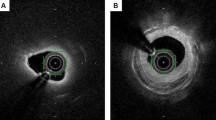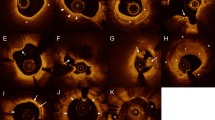Abstract
Optical frequency domain imaging (OFDI) was utilized to compare the prevalence of neoatherosclerosis (NA) and morphological characteristics of the neointimal tissue in second generation drug eluting stent (G2-DES)-treated lesions between early (<1 year, E-ISR) and late (>1 year, L-ISR) in-stent restenotic phases. Data comparing NA and in vivo tissue characteristics between early and late in-stent restenosis (ISR) after implantation of G2-DES is limited. An OFDI analysis was performed in 50 G2-DESs {35 everolimus-eluting stent [22 cobalt-chromium (CoCr), 13 platinum-chromium (PtCr)], and 15 biolimus-eluting stent [BES]} ISR lesions (46 consecutive patients) undergoing target lesion revascularization, classified as E-ISR (n = 22 lesion) and L-ISR (n = 28 lesion). NA, defined as a neointima formation containing lipids or calcification was observed in fewer than half (24/50) of all ISR lesions with no significant difference between E-ISR and L-ISR lesions (50 vs. 46.4%, p = 0.8). There were also no significant differences in the morphological appearance and tissue characteristics between E-ISR and L-ISR lesions. ISR was more likely to occur earlier [median 8.6 (8.3–8.9) months] after PtCr-EES implantations (12 lesions vs. 1, p < 0.001), while 3/4 of the BES ISR lesions and more than 2/3 of the CoCr-EES ISR lesions were observed after 1 year of implantation [median 21.3 (20.7–27.5) months, p < 0.001]. Acknowledging some limitations, our observations may suggest that the prevalence of neoatherosclerosis and the morphological appearance, and tissue characteristics of G2-DESs restenotic lesions are similar between the early and late restenotic phases. Certain platforms (PtCr-EESs) may have preferentially presented with early ISR.


Similar content being viewed by others
References
Mehran R, Dangas G, Abizaid AS, Mintz GS, Lansky AJ, Satler LF, Pichard AD, Kent KM, Stone GW, Leon MB (1999) Angiographic patterns of in-stent restenosis: classification and implications for long-term outcome. Circulation 100:1872–1878
Cassese S, Byrne RA, Tada T, Pinieck S, Joner M, Ibrahim T, King LA, Fusaro M, Laugwitz KL, Kastrati A (2014) Incidence and predictors of restenosis after coronary stenting in 10 004 patients with surveillance angiography. Heart 100:153–159
Tada T, Byrne RA, Simunovic I, King LA, Cassese S, Joner M, Fusaro M, Schneider S, Schulz S, Ibrahim T et al (2013) Risk of stent thrombosis among bare-metal stents, first-generation drug-eluting stents, and second-generation drug-eluting stents: results from a registry of 18,334 patients. JACC 6:1267–1274
Brener SJ, Kereiakes DJ, Simonton CA, Rizvi A, Newman W, Mastali K, Wang JC, Caputo R, Smith RS, Jr, Ying SW et al (2013) Everolimus-eluting stents in patients undergoing percutaneous coronary intervention: final 3-year results of the clinical evaluation of the XIENCE V everolimus eluting coronary stent system in the treatment of subjects with de Novo native coronary artery lesions trial. Am Heart J 166:1035–1042
Lee JM, Park KW, Han JK, Yang HM, Kang HJ, Koo BK, Bae JW, Woo SI, Park JS, Jin DK et al (2014) Three-year patient-related and stent-related outcomes of second-generation everolimus-eluting Xience V stents versus zotarolimus-eluting resolute stents in real-world practice (from the Multicenter Prospective EXCELLENT and RESOLUTE-Korea Registries). Am J Cardiol 114:1329–1338
Natsuaki M, Morimoto T, Furukawa Y, Nakagawa Y, Kadota K, Yamaji K, Ando K, Shizuta S, Shiomi H, Tada T et al (2014) Late adverse events after implantation of sirolimus-eluting stent and bare-metal stent: long-term (5–7 years) follow-up of the coronary revascularization demonstrating outcome study-Kyoto registry Cohort-2. Circ Cardiovasc Interv 7:168–179
Park SJ, Kang SJ, Virmani R, Nakano M, Ueda Y (2012) In-stent neoatherosclerosis: a final common pathway of late stent failure. J Am Coll Cardiol 59:2051–2057
Nakazawa G, Otsuka F, Nakano M, Vorpahl M, Yazdani SK, Ladich E, Kolodgie FD, Finn AV, Virmani R (2011) The pathology of neoatherosclerosis in human coronary implants bare-metal and drug-eluting stents. J Am Coll Cardiol 57:1314–1322
Yonetsu T, Kato K, Kim SJ, Xing L, Jia H, McNulty I, Lee H, Zhang S, Uemura S, Jang Y et al (2012) Predictors for neoatherosclerosis: a retrospective observational study from the optical coherence tomography registry. Circ Cardiovasc Imaging 5:660–666
Otsuka F, Vorpahl M, Nakano M, Foerst J, Newell JB, Sakakura K, Kutys R, Ladich E, Finn AV, Kolodgie FD et al (2014) Pathology of second-generation everolimus-eluting stents versus first-generation sirolimus- and paclitaxel-eluting stents in humans. Circulation 129:211–223
Lee SY, Hur SH, Lee SG, Kim SW, Shin DH, Kim JS, Kim BK, Ko YG, Choi D, Jang Y et al (2015) Optical coherence tomographic observation of in-stent neoatherosclerosis in lesions with more than 50% neointimal area stenosis after second-generation drug-eluting stent implantation. Circ Cardiovasc Interv 8:e001878
Kilickesmez K, Dall’Ara G, Rama-Merchan JC, Ghione M, Mattesini A, Vinues CM, Konstantinidis N, Pighi M, Estevez-Loureiro R, Zivelonghi C et al (2014) Optical coherence tomography characteristics of in-stent restenosis are different between first and second generation drug eluting stents. IJC Heart Vessels 3:68–74
Habara M, Terashima M, Nasu K, Kaneda H, Yokota D, Ito T, Kurita T, Teramoto T, Kimura M, Kinoshita Y et al (2013) Morphological differences of tissue characteristics between early, late, and very late restenosis lesions after first generation drug-eluting stent implantation: an optical coherence tomography study. Eur Heart J Cardiovasc Imaging 14:276–278
Okamura T, Onuma Y, Garcia-Garcia HM, Bruining N, Serruys PW (2012) High-speed intracoronary optical frequency domain imaging: implications for three-dimensional reconstruction and quantitative analysis. EuroIntervention 7:1216–1226
Templin C, Meyer M, Muller MF, Djonov V, Hlushchuk R, Dimova I, Flueckiger S, Kronen P, Sidler M, Klein K et al (2010) Coronary optical frequency domain imaging (OFDI) for in vivo evaluation of stent healing: comparison with light and electron microscopy. Eur Heart J 31:1792–1801
Nagoshi R, Shinke T, Otake H, Shite J, Matsumoto D, Kawamori H, Nakagawa M, Kozuki A, Hariki H, Inoue T et al (2013) Qualitative and quantitative assessment of stent restenosis by optical coherence tomography: comparison between drug-eluting and bare-metal stents. Circ J 77:652–660
Tada T, Kastrati A, Byrne RA, Schuster T, Cuni R, King LA, Cassese S, Joner M, Pache J, Massberg S et al (2014) Randomized comparison of biolimus-eluting stents with biodegradable polymer versus everolimus-eluting stents with permanent polymer coatings assessed by optical coherence tomography. Int J Cardiovasc Imaging 30:495–504
Gonzalo N, Serruys PW, Okamura T, van Beusekom HM, Garcia-Garcia HM, van Soest G, van der Giessen W, Regar E (2009) Optical coherence tomography patterns of stent restenosis. Am Heart J 158:284–293
Nagai H, Ishibashi-Ueda H, Fujii K (2010) Histology of highly echolucent regions in optical coherence tomography images from two patients with sirolimus-eluting stent restenosis. Catheter Cardiovasc Interv 75:961–963
Yamamoto M, Takano M, Murakami D, Inami T, Kimata N, Inami S, Okamatsu K, Ohba T, Seino Y, Mizuno K. Optical coherence tomography analysis for restenosis of drug-eluting stents. Intl J Cardiol 146:100–103
Goto K, Takebayashi H, Kihara Y, Hagikura A, Fujiwara Y, Kikuta Y, Sato K, Kodama S, Taniguchi M, Hiramatsu S et al (2013) Appearance of neointima according to stent type and restenotic phase: analysis by optical coherence tomography. EuroIntervention 9:601–607
Kang SJ, Mintz GS, Akasaka T, Park DW, Lee JY, Kim WJ, Lee SW, Kim YH, Whan Lee C, Park SW et al (2011) Optical coherence tomographic analysis of in-stent neoatherosclerosis after drug-eluting stent implantation. Circulation 123:2954–2996
Jinnouchi H, Kuramitsu S, Shinozaki T, Tomoi Y, Hiromasa T, Kobayashi Y, Domei T, Soga Y, Hyodo M, Shirai S et al (2017) Difference of tissue characteristics between early and late restenosis after second-generation drug-eluting stents implantation—an optical coherence tomography study. Circ J 81(4):450–457
Otsuka F, Sakakura K, Yahagi K, Sanchez OD, Kutys R, Ladich E, Fowler DR, Kolodgie FD, Davis HR, Joner M et al (2014) TCT-655 Contribution of in-stent neoatherosclerosis to late stent failure following bare metal and 1st- and 2nd-generation drug-eluting stent placement: an autopsy study. J Am Coll Cardiol 64
Joner M, Nakazawa G, Finn AV, Quee SC, Coleman L, Acampado E, Wilson PS, Skorija K, Cheng Q, Xu X et al (2008) Endothelial cell recovery between comparator polymer-based drug-eluting stents. J Am Coll Cardiol 52:333–342
Nakazawa G, Finn AV, Vorpahl M, Ladich ER, Kolodgie FD, Virmani R (2011) Coronary responses and differential mechanisms of late stent thrombosis attributed to first-generation sirolimus—and paclitaxel-eluting stents. J Am Coll Cardiol 57:390–398
Vergallo R, Yonetsu T, Uemura S, Park SJ, Lee S, Kato K, Jia H, Abtahian F, Tian J, Hu S et al (2013) Correlation between degree of neointimal hyperplasia and incidence and characteristics of neoatherosclerosis as assessed by optical coherence tomography. Am J Cardiol 112:1315–1321
Yonetsu T, Kim JS, Kato K, Kim SJ, Xing L, Yeh RW, Sakhuja R, McNulty I, Lee H, Zhang S et al (2012) Comparison of incidence and time course of neoatherosclerosis between bare metal stents and drug-eluting stents using optical coherence tomography. Am J Cardiol 110:933–939
Kim JS, Hong MK, Shin DH, Kim BK, Ko YG, Choi D, Jang Y (2012) Quantitative and qualitative changes in DES-related neointimal tissue based on serial OCT. JACC Cardiovasc Imaging 5:1147–1155
Lee SY, Hong MK, Mintz GS, Shin DH, Kim JS, Kim BK, Ko YG, Choi D, Jang Y (2014) Temporal course of neointimal hyperplasia following drug-eluting stent implantation: a serial follow-up optical coherence tomography analysis. Int J Cardiovasc Imaging 30:1003–1011
Guagliumi G, Capodanno D, Ikejima H, Bezerra HG, Sirbu V, Musumeci G, Fiocca L, Lortkipanidze N, Vassileva A, Tahara S et al (2013) Impact of different stent alloys on human vascular response to everolimus-eluting stent: an optical coherence tomography study: the OCTEVEREST. Catheter Cardiovasc Interv 81:510–518
Acknowledgements
Dr. Sabbah was supported by a governmental scholarship for interventional cardiology training and research from Suez Canal University, Egypt.
Funding
No external funding or commercial influence was received in order to conduct the current study. The authors are solely responsible for the design and conduct of this study.
Author information
Authors and Affiliations
Corresponding author
Ethics declarations
Conflict of interest
None.
Disclosures
All authors have no relationship, relevant to the content of this paper, to disclose.
Electronic supplementary material
Below is the link to the electronic supplementary material.
Rights and permissions
About this article
Cite this article
Sabbah, M., Kadota, K., El-Eraky, A. et al. Comparison of in-stent neoatherosclerosis and tissue characteristics between early and late in-stent restenosis in second-generation drug-eluting stents: an optical coherence tomography study. Int J Cardiovasc Imaging 33, 1463–1472 (2017). https://doi.org/10.1007/s10554-017-1146-7
Received:
Accepted:
Published:
Issue Date:
DOI: https://doi.org/10.1007/s10554-017-1146-7




